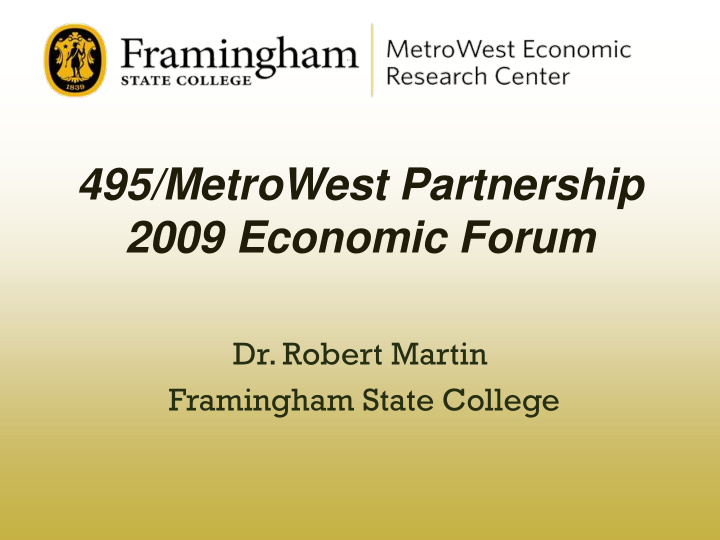



495/MetroWest Partnership 2009 Economic Forum Dr. Robert Martin Framingham State College
2009 Economic Indicators for the 495/MetroWest Region By Christine Doyle-Burke, M.A., Maureen Dunne, M.B.A., and Fahlino Sjuib, Ph.D. with assistance of MERC Interns Stephanie Bogus and Andrew Gallant
SUMMARY OF FINDINGS UNEMPLOYMENT EMPLOYMENT JOB CREATION AND DESTRUCTION
495/MetroWest Unemployment • Since 1992 the 495/MW Corridor has experienced a lower annual unemployment rate than Massachusetts and the United States. • After declining since 2003 the 495/MW unemployment rate climbed to reach 6.3% in January 2009, the highest rate since 1993.
495/MetroWest Unemployment • The gap between the number of people in the 495/MW labor force and the number of jobs located with the 495/MW Corridor, which had widened in the 2001-03 recession, narrowed as the number of jobs grew faster than the labor force between 2003 and 2007.
495/MetroWest Employment • In 2007 the 495/MW Corridor recorded a new historical high of 289,200 jobs, a record payroll of $17.7 billion, and a record average annual wage of $61,300. In 2007 the 495/MW Corridor generated one out of every 11 jobs, one out of every 10 payroll dollars and one out of every 12 establishments in Massachusetts.
495/MetroWest Employment • The 495/MW average annual wage of $61,300 in 2007 exceeded the state’s average wage by 13.3% and the U.S. average wage by 42.2%. • Three supersectors, Trade, Transportation & Utilities (TTU), Professional & Business Services (PBS), Manufacturing, produced over half of regional employment.
495/MetroWest Employment • Two supersectors, PBS with $4.6 billion in payroll, and Manufacturing with $4.3 billion in payroll, together produced half of the 495/MW Corridor’s total payroll in 2007. • Manufacturing led all supersectors in 2007 with an average wage of $97,000, followed by Information ($95,900) and PBS ($84,000).
495/MetroWest Employment • Three high wage supersectors, Manufacturing, Information, and PBS, with 37% to 43% higher concentrations of employment than existed nationally, fueled the region’s economic power. • The Management of Companies and Professional, Scientific and Technical sectors offered the highest average annual wages, $112,400 and $100,700, respectively.
495/MetroWest Job Creation and Destruction • From 2004 to 2007 the 495/MW Corridor added 12,500 jobs or an increase of 4.5%. Over this period the region averaged an annual net gain of 1.5% in employment. • Over the three years, nearly 40,000 jobs were newly created with the annual rate of job creation averaging 4.7% annually.
495/MetroWest Job Creation and Destruction • Over the same three years, nearly 27,000 jobs were destroyed with the annual rate of job destruction averaging -3.2% annually.
495/MetroWest Job Creation and Destruction • Job churning is the sum of job creation and job destruction. • Between 2004 and 2007, the rate of job churning in the 495/MW Corridor averaged 7.9% annually with at least one out of every 12 jobs being created or lost each year.
495/MetroWest Job Creation and Destruction • Between 2004 and 2007 the greatest amount of job churning occurred in the region’s three largest supersectors: PBS, TTU and Manufacturing.
495/MetroWest Job Creation and Destruction • The largest net change in employment among the region’s supersectors occurred in PBS. While over 11,000 new jobs were created, 6,400 jobs were lost resulting in a net increase of more than 4,800 jobs.
THANK YOU For further information, please contact MERC at Framingham State College: 508-626-4033 or on the web: www.merc-online.org
Recommend
More recommend